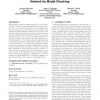Free Online Productivity Tools
i2Speak
i2Symbol
i2OCR
iTex2Img
iWeb2Print
iWeb2Shot
i2Type
iPdf2Split
iPdf2Merge
i2Bopomofo
i2Arabic
i2Style
i2Image
i2PDF
iLatex2Rtf
Sci2ools
PEWASUN
2007
ACM
2007
ACM
Worst-case lifetime computation of a wireless sensor network by model-checking
Wireless Sensor Network (WSN) technology is now mature enough to be used in numerous application domains. However, due to the restricted amount of energy usually allocated to each node, a crucial property of interest for the users is the minimal lifetime of the network. In practice, this value strongly depends both on the design choices performed for each network element (hardware architecture, communication protocols, etc.) and on the whole execution environment (physical environment, execution platform, network topology, etc.). We propose here an original approach to evaluate this minimal network lifetime based on modelchecking techniques. It consists first in designing a timed model of the entire network behavior (taking into account its execution environment), and then to compute on the state space associated to this model the shortest execution sequences (from a temporal point of view) leading to some states considered as “terminal” (from the network lifetime point of view)....
Computer Networks | Execution Environment | Network Lifetime | PEWASUN 2007 | Wireless Sensor Networks |
| Added | 30 Oct 2010 |
| Updated | 30 Oct 2010 |
| Type | Conference |
| Year | 2007 |
| Where | PEWASUN |
| Authors | Laurent Mounier, Ludovic Samper, Wassim Znaidi |
Comments (0)

